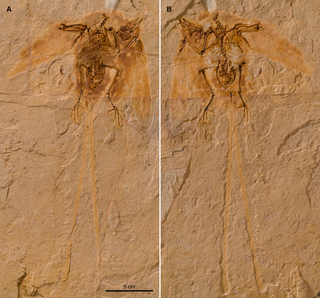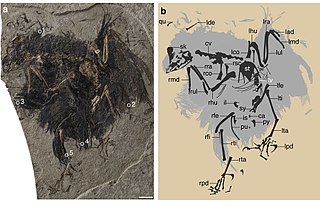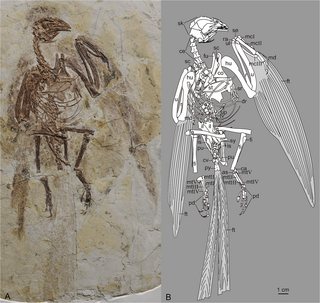
The Enantiornithes, also known as enantiornithines or enantiornitheans in literature, are a group of extinct avialans, the most abundant and diverse group known from the Mesozoic era. Almost all retained teeth and clawed fingers on each wing, but otherwise looked much like modern birds externally. Over eighty species of Enantiornithes have been named, but some names represent only single bones, so it is likely that not all are valid. The Enantiornithes became extinct at the Cretaceous–Paleogene boundary, along with Hesperornithes and all other non-avian dinosaurs.

Sinovenator is a genus of troodontid dinosaur from China. It is from the early Cretaceous Period.

Cathayornis is a genus of enantiornithean birds from the Jiufotang Formation of Liaoning, People's Republic of China. It is known definitively from only one species, Cathayornis yandica, one of the first Enantiornithes found in China. Several additional species were once incorrectly classified as Cathayornis, and have since been reclassified or regarded as nomina dubia.

Cuspirostrisornis is a genus of enantiornithean bird. Only one species is known, Cuspirostrisornis houi, though some researchers believe this to be a synonym of the similar species Cathayornis yandica. It is known from one fossil found in the Jiufotang Formation in Liaoning province, People's Republic of China. The Jiufotang Formation is dated to the Early Cretaceous period, Aptian age, 120.3 +/-0.7 million years ago.

Ornithothoraces is a group of avialan dinosaurs that includes all enantiornithes and the euornithes, which includes modern birds and their closest ancestors. The name Ornithothoraces means "bird thoraxes". This refers to the modern, highly advanced anatomy of the thorax that gave the ornithothoracines superior flight capability compared with more primitive avialans. This anatomy includes a large, keeled breastbone, elongated coracoids and a modified glenoid joint in the shoulder, and a semi-rigid rib cage. In spite of this at least the sternum seems to have developed convergently rather than being a true homology.

Shanweiniao is a genus of long-snouted enantiornithean birds from Early Cretaceous China. One species is known, Shanweiniao cooperorum. There is one known fossil, a slab and counterslab. The fossil is in the collection of the Dalian Natural History Museum, and has accession number DNHM D1878/1 and DNHM1878/2. It was collected from the Lower Cretaceous Dawangzhengzi Beds, middle Yixian Formation, from Lingyuan in the Liaoning Province, China.
Zhongjianornis is a genus of beaked, pigeon-sized birds from the early Cretaceous period of China. It is known from one fossil found at Jianchang, Liaoning Province, in rocks of the Jiufotang Formation, representing the type species Zhongjianornis yangi.

Longipterygidae is a family of early enantiornithean avialans from the Early Cretaceous epoch of China. All known specimens come from the Jiufotang Formation and Yixian Formation, dating to the early Aptian age, 125-120 million years ago.

Bohaiornis is a genus of enantiornithean dinosaurs. Fossils have been found from the Lower Cretaceous Jiufotang Formation of western Liaoning, China. The only known species, Bohaiornis guoi, was named by Dongyu Hu, Li Li, Lianhaim Hou and Xing Xu in 2011 on the basis of a fully articulated and well-preserved skeleton of a sub-adult. This specimen, LPM B00167, preserved two long, ribbon-like feathers attached to the tail rather than a fan of shorter pennaceous feathers. It was similar to the slightly older Eoenantiornis, but much larger in size. Bohaiornis is the type species of Bohaiornithidae, a family of large predatory enantiornitheans from the Early Cretaceous.

Sulcavis is a genus of enantiornithean birds. One species is named, Sulcavis geeorum. The fossil was found in Early Cretaceous rocks in Liaoning Province, China.
Parabohaiornis is an extinct genus of bohaiornithid enantiornithean dinosaur known from the Early Cretaceous of Liaoning Province, northeastern China. It contains a single species, Parabohaiornis martini.

Bohaiornithidae is a group of early predatory enantiornithean dinosaurs from the early Cretaceous Period of China. All known specimens come from the Jiufotang Formation and Yixian Formation, dating to the early Aptian age, 125–120 million years ago. Bohaiornithidae was first coined by Wang and colleagues in 2014. They defined it as the natural group formed by all descendants of the common ancestor of the type species, Bohaiornis guoi, and Shenqiornis mengi.

Yevgeny Nikolayevich Kurochkin was a Russian paleornithologist at the Paleontological Institute of the Russian Academy of Sciences. He served as President of the Menzbier Ornithological Society.
Houornis is a genus of enantiornithean birds from the Jiufotang Formation of Liaoning, People's Republic of China. It is known from a single species, Houornis caudatus, which had been once been classified as a species of Cathayornis, and has also been regarded as a nomen dubium.
Dunhuangia is a bird genus, belonging to the Enantiornithes, which during the Early Cretaceous lived in the area of present China.

Cruralispennia is an extinct genus of enantiornithean bird. The only known specimen of Cruralispennia was discovered in the Early Cretaceous Huajiying Formation of China and formally described in 2017. The type species of Cruralispennia is Cruralispennia multidonta. The generic name is Latin for "shin feather", while the specific name means "many-toothed". The holotype of Cruralispennia is IVPP 21711, a semi-articulated partial skeleton surrounded by the remains of carbonized feathers.
Yangavis is a basal pygostylian genus, belonging to the Confuciusornithidae, that in the Early Cretaceous lived in the area of present China. The type species is Yangavis confucii.

Parapengornis is an extinct genus of enantiornithine bird from the Lower Cretaceous of what is now China. The holotype specimen was discovered in the Jiufotang Formation near Lingyuan, western Liaoning province, and was catalogued as IVPP V18687. The nearly complete, articulated specimen is preserved on a slab and has impressions of pennaceous feathers. Only parts of the sternum, the left hand, and right foot are missing. In 2015, it became the basis of the new genus and species Parapengornis eurycaudatus, named by the Chinese palaeontologists Han Hu, Jingmai K. O’Connor, and Zhonghe Zhou. The generic name consists of the Latin word para and the name of the related genus Pengornis, indicating their close relationship. The name Pengornis is itself derived from "Peng", a mythological bird from Chinese folklore, and ornis, which means bird in Greek. The specific name is derived from the Latin words eury, meaning broad, and caudatus, meaning tail, in reference to the broad and expanded pygostyle. A nearly complete specimen formerly assigned to Pengornis was also reassigned to Parapengornis by these authors.

Yuornis is an extinct genus of enantiornithine bird known from the Late Cretaceous of Henan, China. It contains one species, Yuornis junchangi, named after the late Lü Junchang.















